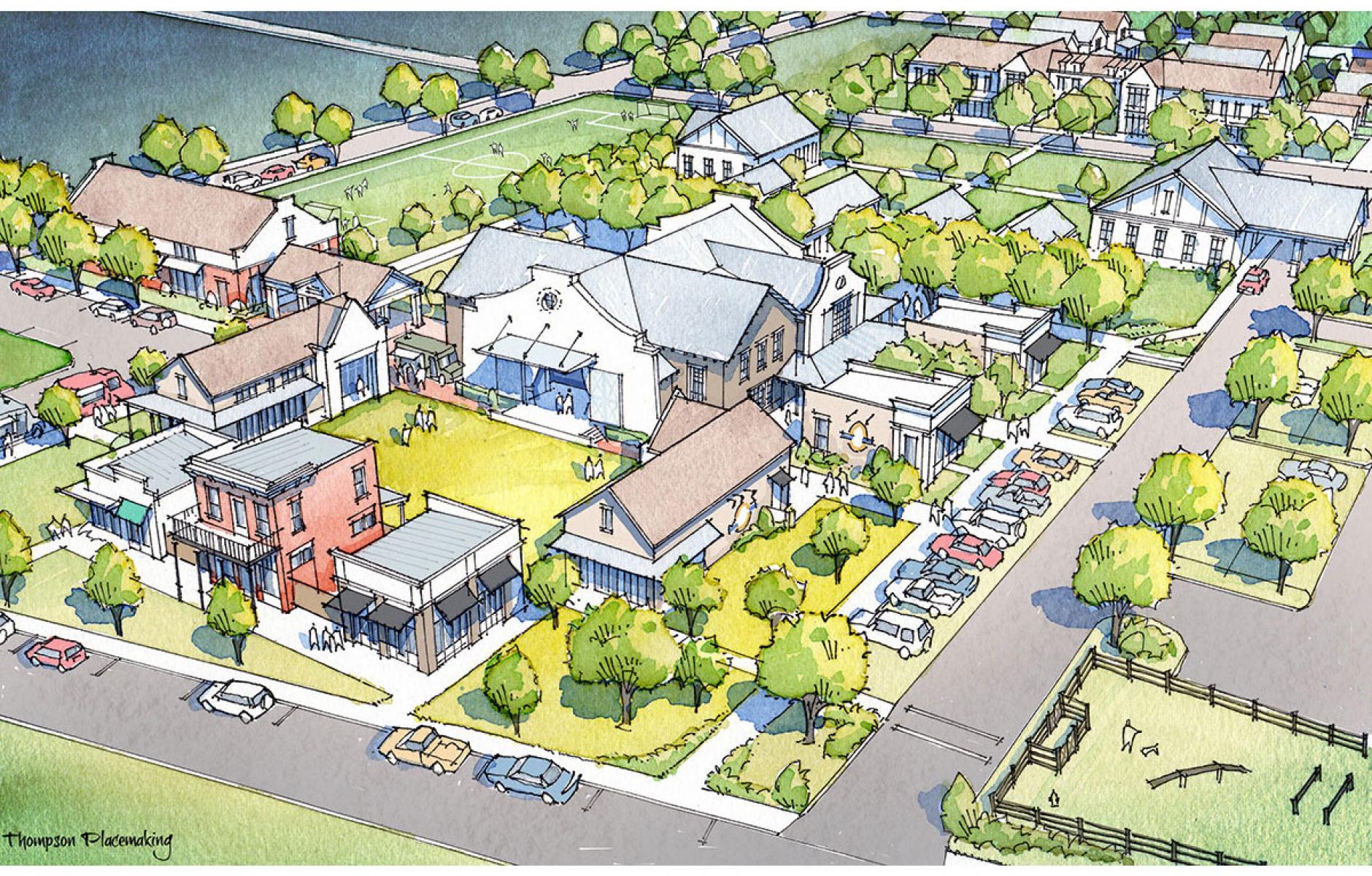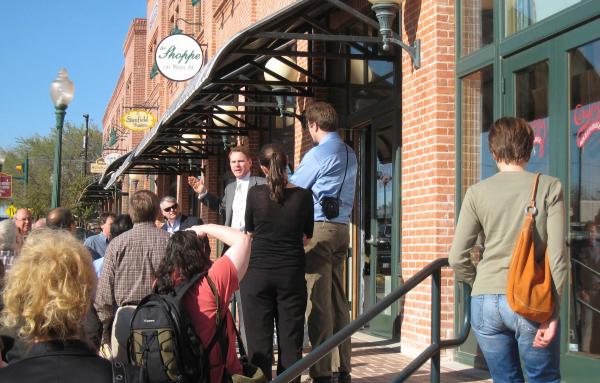
Re-designing Church for the 21st Century
Church participation has been declining in the United States over the past five decades. Hundreds of churches close every month. The closings have increased as an unprecedented percentage of young adults choose to spend their time elsewhere.
But, will the trend continue?
The answer is no if Dr. Patrick M. Quinn, Lead Pastor of Century Church (“Century”) has anything to say about it. This past year Century acquired 23 acres in Pike Road, Alabama, and set out to create a church campus that will abandon the 20th Century church design formula in favor of directly addressing some of the factors that are contributing to decreases in church participation.
“The 20th Century model for building churches focused on the church buildings, whereas we believe that the future of the church is to focus on how to build the community first,” says Quinn. He notes that throughout the centuries the church has always been its healthiest when it focused energy and love outward toward the community.
Instead of creating a large church building that is surrounded by a sea of parking and only used once or twice a week, Century wants to create a campus that is vibrant throughout the week because: (1) it has buildings that cater to the needs of the entire community; and (2) they are designed to be so welcoming and comfortable that people will simply want to hang out there.
To translate this vision into a plan, Century engaged the CityBuilding Partnership LLC to put together a charrette with seasoned practitioners from the Congress for the New Urbanism's Christian Caucus as well as members of the New Urban Guild. All told, more than 20 designers came together to craft the plan that would follow four basic church-building principles that can apply to new or existing churches.
The strong church principles
1. Community first, church second. The most important principle is to look for ways to address community needs before focusing on the needs of the congregation. Within a Christian context, Pastor Quinn believes that this approach "will bring people to the campus who are not looking for Jesus, but who might later realize that Jesus is looking for them."
Application of Principle. In this case Century identified many community needs, but ultimately narrowed the list down to the top priorities which included a community theater, pre-school, culinary incubator, play fields and a fun place to hang out.
The biggest idea to come out of the charrette was to bring several of these individual elements together to form a “hang out” space dubbed “The Well.” Inspired by The Hub on 30A on the Florida Panhandle coast and the Magnolia Market in Waco, Texas, it will be an engaging place where people can enjoy the company of others as they eat, listen to music, talk or play on the green. Since The Well will be the heart of the campus, Century will build it first. As Quinn said, “we must start with the heart.”

2. Partnerships that matter. Historically, many churches have used the bulk of their facilities only once or twice during a typical week. At Century the goal is to maximize the use of all buildings throughout the week because: (a) it will bring more people to the campus (adding more life); and (b) it will help offset the cost of constructing and maintaining the buildings if others are paying to use the buildings on a regular basis.
Application of principle.The community theater can be used for worship service as well as people who lease out the space for concerts, dance recitals, plays and meetings. The pre-school can similarly be used for multiple purposes by functioning as a pre-school throughout the week as well as a worship space for children on Sundays.
Another type of partnering includes Century providing other entities the opportunity to construct buildings on the land pursuant to a long-term land lease for uses that further Century's overall mission. For example, a local faith-based non-profit organization wants to build homes that will house foster care families. So, the charrette team designed a Cottage Court where those houses can contribute toward the life of the campus as well as serve as a wonderful reminder to those who visit Century that foster care might be a great way for them to serve the community.

3. Incremental design. Some churches try to build everything they need in a single building at a single point in time. Other churches construct a single building without a long-range plan for future additions, so when additions are added to the initial building the result is akin to an amorphous blob. These approaches unnecessarily give away the many advantages of an incremental approach such as:
- A faster start. While it might be considered less efficient, developing incrementally allows you to start much faster since it requires less money to build for the inaugural condition than if you build the final or climax condition from the start.
- Greater flexibility. Building structures in smaller increments allows you to adapt to changes that could not be foreseen at the start, learn from any mistakes that were made initially, and grow or contract as demand changes over time. Some view the flexibility gained from this approach as rooted in the humility that stems from understanding that it is extremely difficult to predict what the needs and desires of future generations will be.
- The creation of compelling indoor and outdoor spaces. Building incrementally gives you the opportunity to build individual buildings (as opposed to simply adding onto an existing building) in a manner that can create a compelling outdoor space such as a court, green or plaza. This approach can also enhance the quality of indoor spaces because of the increased amount of natural light that comes with having more rooms that have exterior walls.
- Character from many hands. A place that is designed by one person at one time is usually less interesting than a place where many hands have contributed to the character of the place over time.
- More options for service providers. Development and construction require a wide range of service providers—banks/investors, engineers, architects, contractors, suppliers, etcetera. Building at a smaller scale increases the range of people who can provide services to you (since fewer people/organizations are set up to operate at a larger scale).
Application of principle. Century is fully embracing an incremental approach. The community theater is designed so that it can be expanded upon if necessary.
The pre-school is designed so that it can grow with the placement of additional classroom buildings around the Learning Court. The classrooms are designed so that they can be re-purposed for other uses in the event the pre-school attendance drops at some point in the future.

The YMCA is designed so that it can initially consist of a modest group exercise facility along with a play field next to The Well, while both of those would move when the YMCA is ready to build a full-service facility on the block adjacent to the permanent play fields. Even the dog park was designed to start as a modest amenity adjacent to The Well, then relocate to a larger location if and when the need arises.

4. Sense of adventure and creativity. Adventure and creativity are two concepts that few people associate with churches today, yet they have been common ingredients for successful churches in the past. For example, the Methodist movement grew rapidly in the 19th Century with innovative outreach initiatives such as camp meetings, circuit riders, and less restrictive ordination requirements.
Application of principle. Century's overall plan and approach is undoubtedly an adventurous and creative approach to growing a church because it is based upon: (a) serving the community first; and (b) creating an experience for visitors that cannot be replicated on a television or cell phone screen; i.e., where the experience is premised upon the sense of community that is bolstered by the physical design of the campus. But, there are also other examples of smaller scale creativity worth noting.
First, a Mission Court is designed as a place where small flex buildings provide an incubator space for faith-based organizations that support the mission of the church such as those providing services to those in need.
Second, the community theater is designed so that the stage can face an audience in the building as well as an audience outside on the green of The Well. On the inside of the theater a wide range of seating arrangements are included (booths, individual seats, tables, raised stools, etc.) that provide more welcoming options for a wider range of people.
Third, the campus is not only connected to the surrounding property with its street network, the primary entry street is designed as a main street so that the adjacent property owner can immediately develop half of the main street in a manner that adds life to the church campus.
Develop your recipe
While the four church-building principles are critical ingredients to developing churches that will thrive in the 21st Century, they must be put together with the care required of a great recipe so that they effectively respond to the unique context of each church—whether you have 23 acres in Pike Road, Alabama, or a third of an acre overlooking Central Park in Manhattan. If you would like to learn more about the details surrounding the application of the principles to Century Church, we encourage you to attend CNU 27 in Louisville and attend the CNU Christian Caucus member-led session.
All illustrations courtesy of the CityBuilding Partnership LLC.






